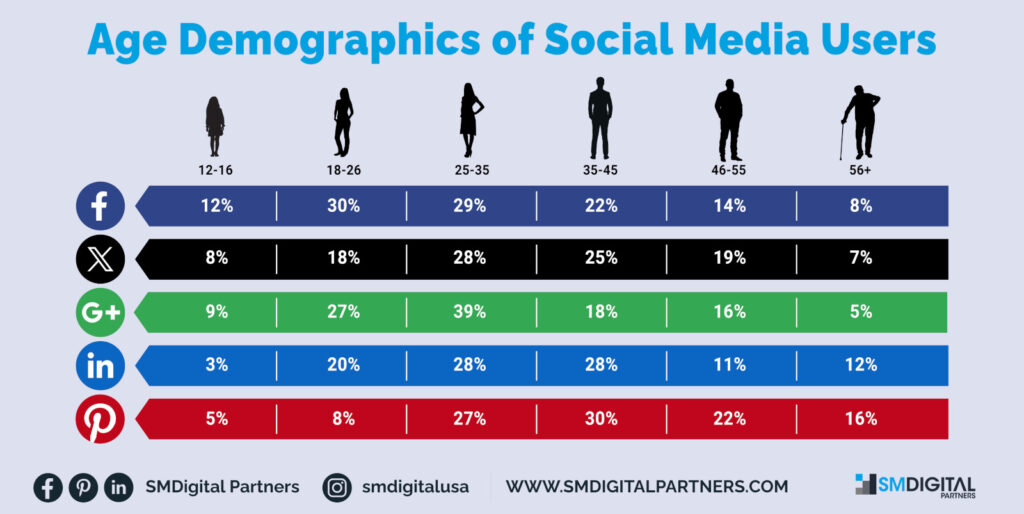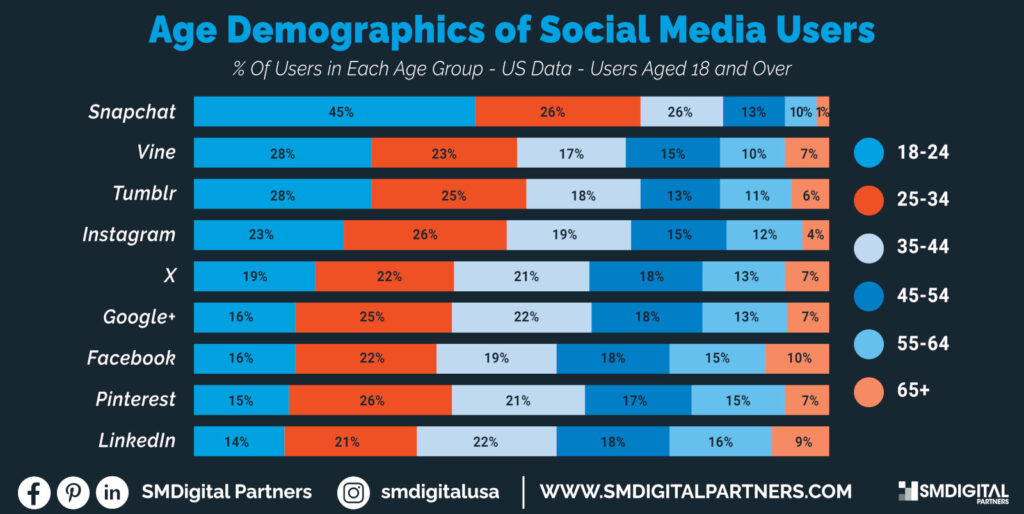In today’s digital landscape, choosing the right social media platform can make or break your marketing efforts. Understanding the age distribution and demographics of users across various platforms is crucial in determining where to focus your social media marketing strategy.
Social Networks Breakdown for Marketing Efforts
Description: Facebook is the largest social media platform globally, offering a variety of content types and interaction features.
Main Content Formats: Text posts, images, videos, live streams, Stories, events.
Demographics: Broad demographic range with a focus on older adults (30+), but also includes younger users. Ideal for businesses targeting a wide audience interested in news, family updates, and community engagement.
Description: A visual-centric platform where users share photos and videos.
Main Content Formats: Photos, videos, Stories, IGTV, Reels.
Demographics: Predominantly younger users (under 35), particularly millennials and Gen Z. Ideal for businesses in fashion, beauty, travel, food, and lifestyle industries aiming to engage with a visually-driven audience.
Description: A microblogging platform focused on real-time information and conversation.
Main Content Formats: Tweets (280 characters), images, videos, GIFs, polls, threads.
Demographics: Diverse user base but skews towards younger adults (under 50), professionals, and tech-savvy individuals. Ideal for businesses interested in sharing quick updates, engaging in industry conversations, and customer service.
Description: The leading professional networking platform.
Main Content Formats: Text posts, articles, images, videos, SlideShare presentations.
Demographics: Professionals, businesses, and job seekers. Skews towards older adults (25-54) with higher education and income levels. Ideal for B2B businesses, thought leadership content, and networking.
YouTube
Description: The largest video-sharing platform globally.
Main Content Formats: Long-form and short-form videos, live streams, tutorials, vlogs.
Demographics: Diverse user base but primarily younger adults (18-34) and teenagers. Ideal for businesses that can showcase products/services through video demonstrations, tutorials, and entertainment content.
TikTok
Description: A short-form video platform known for viral trends and challenges.
Main Content Formats: Short videos (15-60 seconds), duets, challenges, trends.
Demographics: Predominantly Gen Z and younger millennials. Ideal for businesses looking to leverage trends, creativity, and entertainment to reach a younger, trend-conscious audience.
Description: A visual discovery platform for finding ideas and inspiration.
Main Content Formats: Pins (images), videos, idea boards.
Demographics: Predominantly female users, often with higher education and income levels. Ideal for businesses in fashion, food, home decor, DIY, and creative industries targeting a visually-driven audience seeking inspiration and ideas.
Snapchat
Description: A multimedia messaging app known for disappearing content.
Main Content Formats: Snaps (photos and videos), Stories, augmented reality (AR) filters.
Demographics: Primarily younger users (under 30), including Gen Z and millennials. Ideal for businesses that can create engaging, temporary content, leverage AR filters, and connect with a younger, tech-savvy audience.
Each of these social media platforms offers unique opportunities to connect with specific demographics and engage users through tailored content formats. Understanding these differences can help businesses effectively allocate resources and optimize their social media marketing strategies to reach their target audience more effectively.
Age Distribution at the Top Social Networks
Social media platforms cater to diverse age groups, each with its unique characteristics and engagement patterns. Facebook, for instance, remains popular among older demographics, with a significant portion of users aged 50 and above. This demographic tends to value content that is informative, family-oriented, and community-focused.

On the other end of the spectrum, platforms like Instagram and TikTok attract a younger audience, particularly millennials and Gen Z. These platforms emphasize visual content, creativity, and short-form videos, making them ideal for businesses targeting a younger demographic interested in fashion, lifestyle, entertainment, and trending topics.
Age Demographics of Social Media Users
Understanding the age demographics of social media users is pivotal for tailoring your content and advertising strategies effectively. Instagram, known for its visually appealing content and influencer culture, is favored by users aged 18 to 34. Businesses in industries such as fashion, beauty, travel, and food can leverage Instagram’s visual nature to showcase products and engage with a younger, more fashion-conscious audience.

Meanwhile, TikTok has rapidly gained popularity among Gen Z, offering a platform for viral trends, challenges, and short-form video content. Brands looking to capitalize on TikTok’s youthful energy and creativity can create engaging video content that resonates with younger consumers who value authenticity and entertainment.
Finding Your Social Media Sweet Spot
Choosing the right social media platform depends on your target audience, business goals, and the type of content you intend to share. LinkedIn, for instance, is indispensable for B2B businesses looking to establish thought leadership and connect with professionals in their industry. Twitter, with its real-time updates and news-sharing capabilities, is ideal for businesses aiming to engage with a tech-savvy audience interested in current events and industry trends.
Ultimately, the key to successful social media marketing lies in understanding your audience’s preferences and behaviors. By identifying which platform aligns best with your business objectives and demographic profile, you can craft tailored content that resonates with your audience, drives engagement, and achieves measurable results. Whether it’s Facebook’s community-driven approach, Instagram’s visual appeal, or TikTok’s viral potential, each platform offers unique opportunities to amplify your brand’s voice and connect with your target audience effectively.







